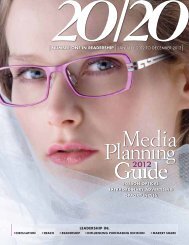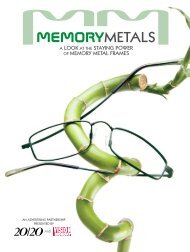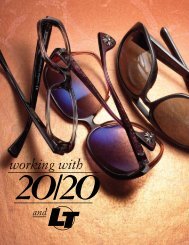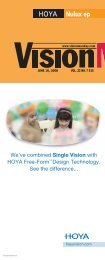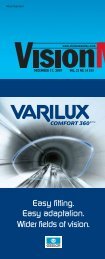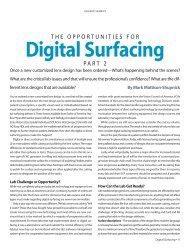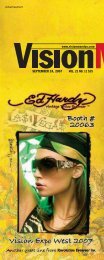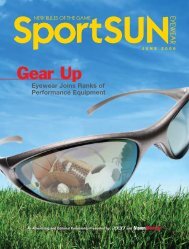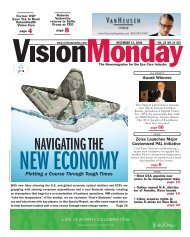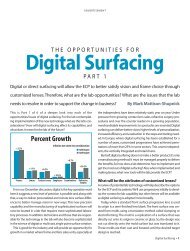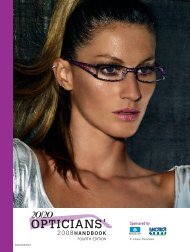Opticians Handbook 2005 - 20/20 Magazine
Opticians Handbook 2005 - 20/20 Magazine
Opticians Handbook 2005 - 20/20 Magazine
- No tags were found...
You also want an ePaper? Increase the reach of your titles
YUMPU automatically turns print PDFs into web optimized ePapers that Google loves.
<strong>Opticians</strong>’ <strong>Handbook</strong><strong><strong>20</strong>05</strong>Sponsored bySafilo and VariluxAdvertisementA Jobson Publication
<strong>Opticians</strong>’HANDBOOKWelcome...Claudio GottardiPresident & CEO, Sàfilo USAMike DaleyPresident, Essilor LensesDear Reader,Sàfilo USA and Essilor ofAmerica are delighted to producethis <strong>Opticians</strong>’ <strong>Handbook</strong>.For the first time a frame andlens company have cometogether to compile a resourceguide about continuing education.It is our goal with this<strong>Handbook</strong> to give the opticianthe tools to grow their professionalknowledge.Continuing Education is acritical factor in the growth ofour industry. It allows the opticianto keep pace with technologychanges in frame and lensmaterials, treatments anddesigns. It ensures that each patient can receive the highestlevel of customer satisfaction. It also provides our commitmentto new products.Use this <strong>Handbook</strong> to locate the next conference nearestyou, web classes available in areas of technical interestor review this text to improve skills and overall expertise.We’ve also added a listing of states that licenseOpticianry and the CE requirements for re-licensure.Consider getting ABO and/or JCAPHO certified if you arenot already certified. It will give you the background to successfullymaster Opticianry and a basis for future growth.This <strong>Handbook</strong> contains important information presentedin an easy to read format. Use it to train your staff.Consider assigning sections for your staff to meet basicknowledge goals.We will update and add to this book periodically becausethe ophthalmic community continues to grow with newproducts and services. We will continue to update thisbook as it is our commitment to provide you a source forthis growth.We are very interested in your comments and suggestionson this handbook as well as additional topics thatyou would like to see covered in the future. Please emailus at opticianshandbook@jobson.com. We look forwardto hearing from you.4 The Patient Experience6 The Prescription8 Definitions9 PD & Segment Height12 Techniques and Technology of Frames18 Lenses—Materials, Treatments and Designs<strong>20</strong> Choose and Use Sunwear More Effectively22 AR Lenses24 Photochromics and Polarized Lenses27 Putting It All Together29 Resource Guide30 <strong><strong>20</strong>05</strong> <strong>Opticians</strong>’ CalendarImages: Sàfilo USA, Essilor of America, Line drawings, pp.9,10, Introduction toOptics, D. Meister, Line drawings, pp.12, 14, Primary, Eyecare Network,Plier photos p.14, Western OpticalCopyright © <strong><strong>20</strong>05</strong>
The PatientEXPERIENCEMaking The AppointmentYou never get a second chance to make a firstimpression. Oftentimes this first impression happens overthe phone. How you behave on the phone creates apicture in the patient’s mind. Is your practice... friendly,technical, clinical, warm, family oriented? Discuss theoffice image you want to project and then come up witha plan to convey this “picture” over the phone to eachand every person you talk to. Mary E. Schmidt, presidentof EyeSystems, an optical consulting firm in Pleasant Hill,Calif., suggests creating a handbook. “An office cancreate their own handbook with information on insurance,fees, policies and services and keep the book at thereception desk as an easy reference guide to be used asa study tool or a training manual for new hires,” saysSchmidt. You’ll be prepared to answer any questions thepatient might have.Pre-AppointingThe most preferable method with this system of settingappointments is a system of pre-appointments. Thepatient’s next appointment is set at the end of their currentappointment. Have the patient fill out their ownreminder postcard or appointment card.This leaves the reminder phone call, a critical ingredientof pre-appointing, in the hands of the staff. When theappointment was set a year in advance, call at the begin-Ten Tips & Techniques for Good Phone Manners1. Answer the phone beforethe third ring2. Smile while you speak—people can “hear” a smile3. Introduce yourself4. Clearly state the nameof the practice5. Don’t eat, chew gum ordrink while answeringthe phone6. Listen carefully and beprepared to answer anyquestions (<strong>Handbook</strong>mentioned above)7. Jot down details8. Use the patient’s name9. Don’t interrupt10. Thank them for callingor for their timening of the month to make sure the day and time that wasset a year ago will still work for the patient. If not,reschedule over the phone at that time, then make areminder call the day before the appointment.When making the call say, “I’m calling to confirm yourappointment for your annual eye exam.” It’s okay to leavea message as long as it’s as professional as theone-on-one call.The Office VisitThe office visit begins the moment the patient walks inthe door. Try to greet every patient within 10 seconds. Ifyou are with another patient, look up and smile beforereturning your attention to your current patient.Fifty-five percent of the initial impression is visual, solooking professional is a must. Dress and behave in aprofessional manner and don’t forget to smile. Try auniform look, such as black tops and khaki pants or anypants and a shirt with the practice logo. It sets a senseof teamwork in the patient’s mind.4 z {Sponsored by Sàfilo USA and Essilor of America}Greeting the PatientWelcome the patient to your practice using their name.Some practices have added a photo to the patient file tohelp the staff recognize patients. Engage them in conversation.Personal details such as “How’s your son doing inthe Navy?” or “How did the wedding go last year?” makea patient feel like you remember them. You can keepshort notes in the file.Offer the patient articles on eye care or a lens menuguide to keep them interested while they wait.The WaitTurn the waiting period from a negative experience to apositive one. When possible don’t make the patient wait.Contact the patient immediately if you know you are runningbehind schedule. Schmidt recommends contactingthe patient via home or cell phone if you are 15 or moreminutes behind schedule. This courtesy goes a long wayin keeping patients happy, even when they do choose tocome in and wait.Unable to reach the patient? Suggest they begin lookingat frames or sunwear while they wait. You can alsodirect them to any educational materials or to a lens technologycenter you might have in the waiting area.Pre-TestingThis will put the patient at ease. Introduce each instrumentbefore each test by explaining what it is, why thedoctor wants the test run and what information the testwill provide the doctor. Schmidt suggests writing out similarscripts for each piece of equipment and mountingthem on the optician’s side of the instrument. Thisinsures that each person administering the test has thesame information. This is also helpful to new staff andprovides consistent service.Update records at pre-testing but NOT at the frontdesk. Use the privacy of the exam room. Make note ofany changes or additions. Then take a few minutes toexplain what will happen next and answer any questions.Loyalty improves with well informed patients.Sometimes patients leave practices. For sixty-eightpercent of patients who leave a practice, this is the resultof what a staff member did or did not do. "It could besomething as simple as an indifferent attitude or impatientdemeanor" explains Schmidt. It's more than walkingout without buying eyewear, patients leave and don'tcomplain. They just change doctors.The importance of a friendly, helpful and professionalstaff cannot be underestimated when creating asuccessful practice.Words to Communicate With The PatientFor the patient, pre-testing is the beginning of their exam. “This is a Visual Field Analyzer. It will indicate toHow you conduct this pre-testing is just as important as the doctor any possible signs of early stage glaucoma.how the doctor conducts their examination. Start byThe doctor will discuss the findings withintroducing yourself and explaining your part in the you during your exam.”process. “Hi Mrs. Walker. I’m Pat and I will be conductingyour tests. Please feel free to ask any questions.”“This is our OptoMap camera. It will provide the“doctor with a full view of your retina to help indetermining the health of your eye.”Turn the waiting period“This is our Auto Refractor. This instrument providesthe doctor with a baseline reading of yourfrom a negative experienceto a positive”prescription for glasses. He/she will fine tune theone.readings during your exam.”www.safilonet.com • www.variluxpro.com • www.crizalpro.com <strong>Opticians</strong>' <strong>Handbook</strong> z 5
THEPrescription(adapted from L&T, Aug <strong>20</strong>04, Palmer Cook O.D.)A Lens FormulaThe prescription, or lens formula, is the starting point forpicking the best lens material, frames, eye and bridgesize. The right choices will turn that lens formula intocomfortable, attractive and well-performing eyewear. Topnotchdispensers see the final eyewear design in everylens formula.Axis and Eyewear SelectionA2. Rx: -0.50-2.50 x 090 OU.In this case the two powers are -0.50D and thecombination of -0.50D and -2.50D or -3.00D. Thislens would have a -0.50D@090 and -3.00D@180.A new dispenser might think that there is little powerbecause of the -0.50D sphere power but due to theaxis the lenses are really -3.00D@180. This willsignificantly impact visible edge thickness.The lens axis tells where the major meridians are locatedand the location of the meridian of greatest power;thickest edge of a minus lens and thinnest edge of a plus.Lens powers are separated into two principal meridians;the axis and 90° from the axis. Illustration A showscylinder axis location when looking at the spectacle wearer.To find the power of the strongest meridian in anycylinder lens, simply compare the sphere power and theCcombined power of the sphere and cylinder together.“1. Rx: OD +3.00-2.00 x 045, OS +2.25Dsphere.Top-notch dispensers seeFor +3.00 -2.00D x 045, the two powers are+3.00D and the combination of +3.00D and -2.00D the final eyewear design inis +1.00D; so the power in the two meridians is+3.00D@045 and +1.00@135. The +2.25 sphereevery lens formula.”power is located at all axes on the lens.See Illustration B.6 z {Sponsored by Sàfilo USA and Essilor of America}BPrismPrism is required when the line of sight must changedirection. A prescription or lens formula with prism, specifiesthe amount and the direction of the base (thickestpart) of the prism. The amount of prism is usually, but notalways, the same in both eyes.• Usually, but not always, horizontal prism is eitherbase in (BI) in both eyes or base out (BO) inboth eyes.• Usually, but not always, vertical prism is downwardin one eye and upward in the other.• When the prism part of a lens formula varies fromwhat is “usually” done, a call to the prescribingdoctor may help avoid making an error in ordering.• When BI or BO prism is specified, try to avoiddecentration. The optical center of the lens is shiftedtoward the geometric center of the eyewire bythe prism component.• When base up (BU) or base down (BD) prismis specified, avoid, using a deep (large Bmeasurement) lens shape.Prism ImbalancePatients do not easily tolerate vertical prism differences,often called vertical imbalance. Individual tolerancevaries, but a difference between the right and left lens ofone prism diopter (1∆) or more of vertical prism cancause asthenopia, (eye strain) adaptation problems, readingdifficulties and even diplopia (double vision). Patientswith single-vision lenses and vertical prism imbalanceusually learn to turn their heads to read through the lensesat a point closer to the optical centers.Prism imbalance tolerances of 2/3∆ horizontally and1/3∆ vertically are generally acceptable. For patientswith greater vertical prism imbalance who must lookdown to read, slab-off design or reading lenses shouldbe considered.Lens Formula Tips• If the strongest meridian falls close to the 180°line, lens thickness will be more affected bydecentration. Select frames where the patient’spupils are close to the geometric center ofthe lenses.• Thicker lens edges in minus lenses areless attractive.• Increased center thickness in plus lenses meansgreater magnification. In strong plus powers thismeans a reduced field of view for the patient andundesirable “magnified eyes.”• Added thickness means added weight in all lenses.• For strongest meridians that fall close to 90° orstraight up and down, avoid deep (i.e. large Bmeasurement) frames.• The effective diameter (ED) of a lens shape isdefined as twice the longest radius of the shape.The longer the ED, the thicker the finished lenswill be.• For strongest meridians in plus powers, the centermust always be thick enough to allow sufficientmaterial at the edge of the lens.www.safilonet.com • www.variluxpro.com • www.crizalpro.com <strong>Opticians</strong>' <strong>Handbook</strong> z 7
PDandSEGMENT HEIGHTDefinitionsAxis NotationBDBIBOBUCombiningPowersDecentrationDBC (Frame PD)EDMajor orPrincipalMeridiansLens power location is specified according to a pattern similar to the face of a clock. Zero degreesis always on the patient’s left. The horizontal (180°) meridian would be a line passing through thethree and the nine, the vertical (90°) meridian through six and 12. The one to seven line would bethe 60° meridian and so on.“Base down” prism; the thickest part (base) of the prism is directed vertically downward.“Base in” prism; the thickest part (base) of the prism is directed horizontally inward towardthe patient’s nose.“Base out” prism; the thickest part (base) of the prism directed horizontally outward away fromthe patient’s nose.“Base up” prism; the thickest part (base) of the prism directed vertically upward.Combining lens powers is algebraic. For example +1 combined with +1 is +2, and +1 combined with+3 is +4. And +1 combined with -1 is 0, while +2 combined with -3 is -1.The distance in millimeters that the Major Reference Points must be displaced from the eyewiregeometric centers.The distance between the geometric centers of the eyewires. To calculate, add eye size and bridge size.Twice the longest radius.The axis power meridian and the meridian 90 degrees from the axis.Taking PDsMeasure the distancebetween thevisual axesof the two eyes;manually with aruler or automaticallyusing a pupillometer.The pupillometeris moreaccurate as well asmore consistent.Distance PDUsing the PupillometerPlace the nose pads on thepatient’s nose with the foreheadbar in place helping tocenter the instrument onthe nose. Ask the patient tohold the pupillometer as ifthey were holding a pair ofbinoculars and look at thelighted circle.1. Set distance wheel to infinity (∞) for far PD or thecorrect near distance 35cm=~14 inches,40cm=~16 inches, 45cm=~18 inches2. Always take monocular PDs.3. Record the findings (take it again to be sure).4. Use the paddle to occlude either eye if the patienthas difficulty with both eyes focusing on thering target.PD Distance with a Ruler1. Sit directly in front of the patient and at the sameheight as the patient.2. Place your pointer finger (left hand) in front of yourleft eye and ask the patient, with both eyes, to lookat your finger. The patient’s right eye is lookingstraight ahead.3. Set the zero point of the rule at the innerpupil margin.4. Move your pointer finger in front of your right eye andask the patient to look, with both eyes, at your finger.5. Measure to the outer pupil margin of the patient’sleft eye. This is equivalent to the distance from pupilcenter to pupil center.Minimum LensThicknessMinus lenses are determined by center thickness, material and impact strength. Plus lens thicknessis determined by the thinnest edge possible at the farthest lens edge. Consult ANSIZ80.1-1999and your lab.MRPThe point in the lens that gives the prescription. Bifocals have two MRPs, distance and near.PDThe distance between visual axes of the eyes. For far or near vision.Prentice RuleThe calculated prism at any point in a lens; equal to the distance in centimeters from the opticalcenter of the lens times the power of the lens in diopters. The direction of the prism will be in, out,up, down or a combination, ∆=dxf.8 z {Sponsored by Sàfilo USA and Essilor of America}www.safilonet.com • www.variluxpro.com • www.crizalpro.com <strong>Opticians</strong>' <strong>Handbook</strong> z 9
Techniques& TechnologyOF FRAMESBefore DeliveryDelivering a frame to a patient that sparkles is key toenhancing the office image. Be sure that the frame isstraight, symmetrical and clean, clean, clean.1. Straighten thebridge so thecurves are uniformand the eyewiresare aligned.2. Give the frame aslight face formbend.3. Next, be sure thatnone of the eyewiresare rolled (happens on an overly heated plasticframe during glazing)—if they are, heat the eyewire,remove the lens, heat the eyewire again and roll theeyewire back into shape and insert the lens.NoNoYes5. Test for tilt with theframe upsidedown.Both temple topstouch the table atthe same time, “fourpoint touch.”6. Next, place frameright side up.Temple ends are thesame angle whenboth touch the tableat the same time.This checks that theframe is completelysymmetrical.Frame Delivery – Basic Adjusting1. Place the frame on the patient and adjust for slighttemple tension without indenting the head.OK OK NO NO NO4. Make sure temples are near parallel and eyewires are“not propellered.Delivering a frame to aYes No Nopatient that sparkles is key toenhancing the office image”12 z {Sponsored by Sàfilo USA and Essilor of America}
2. To raise the right side of theframe, lower the right temple(lowering the temple raises thefront of the frame on that side).3. Raise or lower the temples toadjust pantoscopic angle. Use awide angling plier or parallel jaw pliers. For someframes pliers may be required to stabilize the frontwhile the temples are bent up or down.American Pad Arms• Grasp the pad andbend the arm downat the frame frontattachment.• Straighten the padarm so the pad isangled to fit flatagainst the nose.(Pad removed for visibility)The Boxing SystemBoxing 2Boxing SystemYesNoNoInserting Lenses—Zyl Frames• Heat the eyewire until soft.• Insert through the front.Spring HingeTemple Length4. Always look behind the earand contour the temple forangle and touch. The moretemple in contact the moresecure the fit. Lastly, anglethe temple so that its bendoccurs at the crest ofthe ear.Better• Place the temporal side in first, to the depthof the bevel.• Place top bevel into the eyewire.• Insert the nasal side.• Pull the rest of the eyewire around the lens.Adjusting Nose PadsPads should rest halfway between the crest of the noseand the inner canthus. Find the spot with the most support,make the pads flush with the nose surface and usethe pads to raise or lower the frame or increase ordecrease vertex distance.Looped Pad Arms• Raise the pads to lowerthe frame, lower thepads to raise the frame.• Straighten the loop,Make a sharp bend nearthe attachment point.• Angle the pad to sitflush on the nose.(Illustration exaggerated)Saddle BridgeEyewire FrontGrooved RimlessNylon CordFrame FrontPad ArmBridgeLibrary TempleNose PadSkull TempleEnd PieceHingeBarrelsABGDBCDBLEDHorizontal Eye Size. Width between two verticallines tangent to the edges of the lens.Vertical height between two horizontal linestangent to lens edges.The geometric center of the imaginary boxenclosing the edges of the finished lens.Distance Between Centers. The separation betweenthe geometric centers of right and left lenses.Bridge size. The minimum distance between thetwo lenses.Effective Diameter. Twice the longest radius; thesmallest circle that will completely enclose the lens.14 z {Sponsored by Sàfilo USA and Essilor of America}www.safilonet.com • www.variluxpro.com • www.crizalpro.com <strong>Opticians</strong>' <strong>Handbook</strong> z 15
Material Features & BenefitsIndicates MetalsIndicates PlasticsMaterialsAluminum andAnodized AluminumArgesteBetaTitaniumMonelScandiumSafitex ®Surgical Stainless SteelTitanium(T100 = >90% titanium)Zyl, Plastic Acetate(zylonite or "zyl")Cellulose Propionate(propionate)GrilamidOptyl ®TrogamidInfo• Light & strong (50% lighter than titanium)• Little flexibility, adjusting riveted hinges difficult• Anodized, Stronger, less scratch resistant than Aluminum• Imbedded spring hinges available• Latest generation Surgical Stainless Steel• Nickel free• Flexible• Strong & lightweight alloy of titanium, vanadium• No nickel• More flexible than pure Titanium• Most used frame metal, easy to shape• Copper & nickel in a 2:1 ratio• Strong solders and finishes• Highly ductile, shapeable and corrosion resistant• 40% Lighter than titanium, ultra lightweight• Unique ultra durable alloy• Great designs without soldering or welding• Flat metal cut from one sheet• Lighter than regular metal frames• Sàfilo provides the highest quality available, 100% Nickel Free• Corrosion resistant combines lightweight with strength forcomfort and durability• Extremely lightweight• Highly durable• Corrosion resistant• Polishes well, electrolytic color finishes• Casting adds design features• Adjusts well• Most common, all colors, patterns• Made from cotton seed fiber, wood flakes and plasticizers• Softens over time requires readjustment, too much heat canmelt or burn the frame• Metal temple core is required for rigidity• Frame can dry out or become brittle, acetone will dissolve theframe heat to 1<strong>20</strong>°C to adjust• Injection molded, lighter than plastic acetate• Lightweight, strong and flexible, color is added byan over-coating• Excess heat bubbles the frame, beads will pock the surface• NO acetone or alcohol• Thermoplastic molded frame• Lightweight, <strong>20</strong>% lighter than zyl• No plasticizers to dry out• Cold glazing for thin lenses, slight heat for highpowers,
LENSESMaterials, Treatments& DesignThe interrelationship of lens materials, treatments anddesign allows the best selection of options for every wearer.Be sure to describe material characteristics in patientrelevant terms. Not “higher index and lower density” but“thinner and lighter lenses.” Not “Abbe” but “Improvedperipheral clarity in higher powered lenses.” Materialswith “increased impact strength” can make minus lenseswith thinner centers and provide improved protection.“UV absorptive” lenses protect the eye from UV’s damagingeffects. “Photochromics” provide increased comfortand UV protection while significantly reducing glare.“Anti-reflective lenses” allows the wearer to see and beseen more clearly. “Polarized sun lenses” improve safetyand provide comfort by eliminating blinding glare.Thinner and LighterHigher index lenses requireless material to produce thesame lens powers. As a result,the edges of minus lenses andthe centers of plus lenses arethinner. Less lens volume alsomakes lenses lighter. Lowerdensity creates an even lighterlens. For example the table tothe right describes how polycarbonatemakes a thinner andlighter lens.Ultraviolet AbsorptionPlastic lens materials include UV absorbers to protectthe eye from UVB (280-315nm), which causessunburn and UVA (315-380nm), which has beenlinked to the formation of cataracts, macular edemaand age related macular degeneration (AMD). So, alllenses should be UV protective. Moreover, sincemost damage occurs before age of 30 (QueenslandInstitute of Medical Research), consider UV attenuatinglenses and sunglasses for all kids and youngadults.Poly Hard Resin Poly BenefitsIndex 1.59 1.50Density 1.21 g/cm 3 1.32 g/cc3Impact Excellent GoodMaterialCrown glass1.60 glassHard resinHard resin w/uv dyeMid IndexPolycarbonate1.60 High Index1.67 High IndexTransitionsPolarized1.701.74The higher index means that less material isneeded for the same power; the result is thinneredges in minus, thinner centers in plus andlenses weigh less.The material is inherently lighter so lenses arelighter as a result.Increased impact strength allows thinner centers,as thin as 1.0mm in minus lenses (2.0mmfor hard resin lenses).Cut-off~285nm~330nm~360nm~380nm~370-375nm~380nnm~380nm~400nm~380nm~380nm~380nm~400nm% UV Absorption39%84%90%100%95-98%100%100%100%100%100%100%100%18 z {Sponsored by Sàfilo USA and Essilor of America}Glare and Anti-Glare Lenses“Anti-glare” lenses effectively reduce or eliminate glare,increase patient comfort, acuity, safety and cosmeticappearance. There are four kinds of glare in eyewear.Types of GlareDistracting GlareDiscomforting GlareDisabling GlareBlinding GlareCause and Effect• Caused by reflections from thelens surface• Causes eye fatigue• Caused by everyday bright light• Can occur even when cloudy• Causes squinting and eye fatigue• Caused by excessive intense light• Blocks vision• Caused by light reflected offsmooth, shiny surfaces• Blocks visionTreatments That Reduce or EliminateAR LensesHow much thinner and lighter? Use the table below.Wearing now… New lenses… You can expect…GlassHard resinHard resinHard resinPoly or High IndexMaterial DetailsHard resinCrown glassTrivex (Trilogy, Phoenix)SpectraliteMid Index plasticPolycarbonateHigh Index plasticHigh Index glassUltra High Index plasticUltra High Index glassUltra High Index plasticUltra High Index plasticHard resinPolycarbonateHigh IndexUltra High IndexUltra High IndexAbout 10% thicker, but half the weightUp to 25% thinner and lighterUp to 25% thinner and lighterUp to 40% thinner and lighterUp to 15% thinner and lighterIndex (rounded) Abbe Density (g/cm3)1.501.5231.531.541.55-1.561.591.601.601.671.701.701.745858454736-4030424032303633Photochromics (such as Transitions), light tints, lightdensity polarized lensesPhotochromics (such as Transitions), dark tints,polarized lensesOnly polarized lenses remove blinding glareUltra Hi-Index vs. Hard Resinwww.safilonet.com • www.variluxpro.com • www.crizalpro.com <strong>Opticians</strong>' <strong>Handbook</strong> z 191.322.541.111.211.281.211.302.621.363.651.351.46-4 Thin & Lite 1.67-4 Hard Resin
&Choose UseSunwear More EffectivelySunwear sales satisfy patient needs and build business.Prescription sunwear is essential for eye health and comfortin all outdoor activities. Remember, multiple pairsales will grow your business.Consumers Are Better InformedYou should be knowledgeable about all sunglass optionsbecause your patient is well informed. The web, retailstores, advertising, movies—even your competition areinfluencing your patients. You need to be well informed.Growing Sunwear SalesHere are simple suggestions to make any office successfulat selling sunwear.• Make sunwear important by dedicating sunwearretail space. It shows patients you are committedthe category.• Have up-to-date selections; fashion trend framesand the newest lens colors and coatings.Suggestion—Contact your Sàfilo representative forthe latest advice on the best sunwear, hottestsellers and fashion trends in the variety ofSàfilo collections.• Review the sections of this <strong>Handbook</strong> to ensurethat dispensers and doctors understand thebenefits of tints, polarized and photochromics.Discuss the advantages and benefits of frame materialsto the wearer. Use the tint, photochromic andglare demonstrators to ensure that patients knowthe benefits of your recommendations. If your’s is adoctor’s office, discuss sunwear in the exam room.“Tints can effectively reducesunlight for wearer comfortand also provide a visualexperience”• Identify and use branded or customized sun Rxprograms that can differentiate the business.• Identify opportunities, set goals and measureresponse. Is the office more successful than lastmonth, quarter, year? Are all contact lens patientsshown sunwear? Do you sell sunwear all year?• All dispensers should wear contemporary sunwear;selling from personal experience is smart.Color in lenses adds individuality, fashion, and protectsfrom glare. Tinting is an effective way to bring customizationand benefit to any patient.Tints can effectively reduce sunlight for wearer comfortand also provide a visual experience that can improve visibilityof golf balls in the air or on the green or identifypatches of ice in the snow while skiing. It is important tomatch color to fashion and performance. For fashion suggestions,look at the tinted lens colors used in the Sàfiloand Essilor sunglass collections. For specific applicationsuse the opposite table as a guide. The results give youthe ability to marry fashion and performance to meetevery patient’s needs.Polarized sunwear, especially in prescription isbeneficial. Most dispensers agree, as the majority of prescriptionsunwear sold is polarized. Patients who haveworn polarized lenses will buy them again. For general useconsider Grey or Brown; For window shopping, photochromics provide flexibility in and out of doors. Use thetable opposite to match color and need, then combine itwith polarized for high performance.<strong>20</strong> z {Sponsored by Sàfilo USA and Essilor of America}Which Lens Is Best?ActivityBaseballCyclingDrivingFishingGolfHuntingMotorcyclingRacquetballSkiingSwimmingTennisWater SportsRecommended Color(s)Gray or GreenPolarizedMost BrownsSome GreensGray or Brown PhotochromicsPolarizedGray or BrownPolarizedBrown, Amber and GrayPolarizedGreen and BrownYellow, Orange, Red andContrast BrownsPolarizedMost BrownsSome Gray and Green LensesPhotochromicsPolarizedYellow and Orange, ClearYellow, Orange and BrownPolarizedClear, Light Blue, Light YellowYellow and Orange, ClearPolarizedAll Polarized Brown or GrayPolarizedComments• Green or Gray is the better choice to highlight the ball against thesky or grass.• Mirrors can help enhance contrast.• Back surface AR blocks reflections at critical times.• Bright sunlight—High contrast Brown and Greens also polarized inBrown or Contrast tint Brown enhance contrast.• Low light—Yellow, Red or Orange.• Photochromic lenses are increasing in popularity due to UV and thevariable density feature.• Back surface AR.• In general use Gray or Brown as dark as needed for driving comfort.• Polarized lenses are a must.• Polarized is important depending on the type of fishing. Both Grayand Brown work well, as does Contrast Brown.• For flats, lake and stream, Brown is recommended. For open water ordeep sea, Gray is recommended.• The ball needs to be highlighted against the sky and the grass.• The background and the specifics of driving vs. putting have variedand opposite color requirements.• Brown is preferred and density can be tuned to personal preference.Polarized with back surface AR is a plus.• Most hunters require multiple lens choices.• Yellow, Amber, Orange and Red or light lenses work great in lowlight conditions.• Contrast Browns or darker lenses work better in bright conditions.• Suggest frames with interchangeable lenses or multiple pairs.• Contrast Brown since contrast enhancement is key at high speedplus backside AR can improve safety.• Polarized is good for road vision but some instrument clusters areLCDs and polarized lenses could cause problems.• Photochromic is increasing in popularity in large frames or in wrapswhere a UV absorbing face shield is not used.• Primarily indoors—Yellow or Orange heightens ball visibility.• Clear with AR is also a good choice.• Brown, Amber or Brown-yellow lenses are excellent choices.• Yellow or Orange and Contrast Brown (high VLT) for low light conditions• AR and flash mirrors are good to diminish the reflection of water.• For competitive swimming use clear lenses, flash mirrors, back AR.• General purpose—Yellow tinted lens will pick up the yellow ball better.• Outdoors, yellow will be too bright and allow in too much light. UseOrange or Brown.• Polarized lenses reduce blue light and light scatter off water.• Choose Gray family colors for general water activities.www.safilonet.com • www.variluxpro.com • www.crizalpro.com <strong>Opticians</strong>' <strong>Handbook</strong> z 21
ARLensesAnti-Reflective Lenses are essential for every patient.They make eyewear premium and custom for wearerswhile improving vision and looks. If 8-12% of light is lostdue to surface reflections, there is a loss of acuity andclarity due to the visual noise created by lens reflections.Add the effects of dirty lenses and a part of everypatient’s world is a blur. This causes eyestrain and fatigueand may also create a safety hazard by hiding importantthings that need to be seen.Today’s premium AR allows more than 99% of the lightreaching the lens to get to the eye. This reduces eyestrainand fatigue providing clearer, more comfortableand productive vision. And, while the wearer sees moreclearly, the world sees the wearer’s eyes more clearlyalso improving communication and looks. Better acuitycan improve safety, especially at night by eliminatingghost images and halos.New AR topcoats make lenses even easier to clean bybeing hydrophobic and oleophobic i.e., even oils can beeasily wiped off with a cleaning cloth. Surface dirt is lesslikely to scratch the lens during cleaning. Chemicalresistance, repellency, abrasion-resistance and ease ofcleaning is significantly improved. The end result is anadded patient benefit as most AR coatings producedtoday are as easy to clean as normal lenses.Here are some answers to commonquestions that patients ask.Do AR lenses get dirtier than normal lenses?They don't. With normal lenses, reflections tend to hide thedirt whereas with AR lenses, because they are so much clearer,it is easier to see the dirt. It is like an early detection system.With AR lenses, the dirt is noticeable and causes thepatient to clean their lenses more often resulting in better andsafer vision.What is the best way to care for AR Lenses?Recommend a regular lens cleaning regimen, complete witheasy-to-use AR specific products that fit the active lifestylesof your patients. Ask your AR provider what lens cleaningproducts they currently have available:• Lens spray cleaner, specially designed for antireflectivelenses• Microfiber lens cleaning cloth• Patients will typically experience the best results whenusing cleaners specifically designed for AR lenses.AR Dispensing TipsEvery patient can benefit from more light to the eye. And every patient should be given that opportunity.Practical benefitsFunctional Benefits Cosmetic Benefits• Night driving• Computer use• Sunglass wear• Sports activities• Visually demanding occupationssuch as police officers,firefighters and pilots• Clearer vision• Better acquity• Reduced eyestrain• People see you, not your lenses.• Attention focuses on your eyes,not the distracting glare.• AR on photochromic lenses lookclearer indoors and eliminate theglare that can occur in the dark.22 z {Sponsored by Sàfilo USA and Essilor of America}
& LENSESBlinding glare results when bright light is reflected offa surface like wet pavement early in the morning. Thereflected light is polarized i.e., reflected only horizontallyand is increased in brightness 10-100 times. The resultis blinding.Polarized lenses absorb horizontal glare using a polarizingfilter suspended within the lens. The filter is made upof iodine crystals arranged to block light but let lightin all other directions through. The result is clearcomfortable vision.Photochromics PolarizedPhotochromics are one of the most effective methods ofensuring patient eye health and comfort. These lenseschange density depending on outdoor conditions so that,as Transitions says, they’re “Right in any Light.” UVmakes them dark and when UV is present, the lensabsorbs UV, this changes lens density and two benefitsare realized. The eye is protected from UV damage andthe darkening provides comfort in a variable tint lens.Lenses get as dark as sunglasses and yet are clearindoors. The chart below shows the range of transmissionfor new Transitions V lenses, with and without AR. ARcoated poly or high index lenses are 93% transparentwhile being able to quickly get 84% dark. In fact thespeed of darkening easily meets patient’s expectationsfor performance and cost. With new Transitions V lenses,all premium materials have the same fast darkening andclearing characteristics of hard resin Transitions.AR coated photochromic lenses effectively reduce orcompletely eliminate distracting, discomforting and disablingglare. Premium AR does not interfere with photochromicperformance.Patients appreciate lenses that are 100% automatic UVand glare protective. Be sure they understand photochromicsare UV activated and car windshields alsoabsorb UV, therefore photochromics do not have the sameperformance for driving. Of course, clear lenses don’t getdark inside the car either, so recommend a dark tint or apolarized pair of sunglasses. Variable tint or photochromicsare one of the best general purpose lenschoices for everyday wear; add a polarized clip for drivingor a second pair of polarized sunglasses.Polarized sun lenses are the preferred sunlens and theyare available in colors to meet almost all patients’ needs.Polarized lenses improve visual acuity, eliminate blindingglare for better vision in all daytime conditions.Selling polarized lenses is easier than you think. Simplydemonstrate them. Dispensing table displays show howreflections block images on the display in the same wayreflections block vision when driving. A polarized lenslorgnette allows the patient to look at the display and thereflected light obscuring the display is blocked. Only thedisplay photo is visible. It’s that easy. Once the patienthas worn polarized lenses, they’ll usually purchasethem again.Without polarized lenses a patient’s vision in bright,direct or reflected sunshine can be impaired outdoors.Colors are distorted, there’s poor depth perception andthere can be extreme discomfort. Have this happen justas you drive through a crosswalk a child in the crosswalkmight not be seen. Polarized sunglasses totally eliminateblinding glare for safer vision.24 z {Sponsored by Sàfilo USA and Essilor of America}Lens DesignThere is a small range of spherical curve combinationsthat provide good vision for a range of prescriptions. Thatis why minus Rxs typically have flatter front curves thanplus Rxs. The front curve chosen by the laboratory or thefront curve on a finished stock lens for any particular Rxis specified by the lens manufacturer. This front curve iscalled the Base Curve. As a result, it is better to allow thelab to choose the appropriate base curve for the Rx thanrequesting that the patient’s base curve stay the same.This is especially important when ordering aspherics,atorics and progressives. The asphericity used in lensesis optimized to the Rx and the base curve. Changing itcan affect the patient's vision.A progressive lens front surface changes to allow anincrease in plus power for the addition. The corridorlength, inset of the near and management of the lensperiphery is designed by the manufacturer. Modern progressivesinclude variable corridor lengths and inset, flattenedfor better looks and designed to meet the specificneeds of presdyopes.Single VisionSingle vision lenses have one focus or power. The Rx maybe for distance or near and so the correct PD for distanceor near vision should be used when ordering lenses.Bifocals and TrifocalsBifocal lenses have two foci or powers—(distance andnear) Trifocals have three. The Rx is typically for distanceand near or may be for intermediate and near. The near PDis used for the placement of the segments.Progressive LensesProgressive lenses typically have all powers from distanceto near. The distance monocular PD is used for theplacement of the fitting cross. Distance and near powerare checked using the distance and near power checkingcircles. The manufacturer’s inked center dot notes theoptical center if there is no prescribed prism or if there is,it is the point of prescribed prism.Lens curves used:8”+3.00+4.00+6.00Sphere Only Lenses12”+2.25+3.00+4.50Add16”+1.50+2.00+3.00Lens with CylinderLenses Front Back Front BackSV, FT, FTTrifocals Spherical Spherical Spherical ToricAspheric SV Aspheric Spherical Aspheric ToricAtoric SV Spherical Aspheric Spherical AtoricProgressive Progressive Spherical Progressive ToricProgressive lenses are marked in two ways so they canbe identified. The semi-visible engravings allow restorationof the fitting marks. Locate them in plus Rx lenses bylooking though the lens. Hold the lens about 12 inchesaway while moving the lens across a dark/light border.For minus lenses, locate them by reflection. Hold the lensso an overhead light is reflected onto the front surfaceand tilt the lens so the reflection floods the front makingthe engraving visible. Mark them using a felt tipmarker. A PAL ID device is worth buying. It lights upthe engravings.Near Variable Focus LensesTo understand NVF lenses, add power is the key. The doctordetermines the add power at a specific reading distance.With reading distance and add, adjust the add formidrange distances. In the example below a +2.00 addwas prescribed for a 16 inch reading distance. Thepatient would need a +1.00 at 32 inches (1/2 the add attwice the distance using D=1/f). From that relationship,the following table can be developed for a variety ofadds and working distances. See the Rx changes atvarious distances.www.safilonet.com • www.variluxpro.com • www.crizalpro.com <strong>Opticians</strong>' <strong>Handbook</strong> z 2532”+0.75+1.00+1.5048”+0.50+0.67+1.00
AsphericitySpherical design plus lenses have steep front curves, andmagnify the eye. For better looking lenses with flatterfront curves, use aspheric lenses. The patients eyes (andthe world they see) will appear more natural. Asphericsare available in plus and minus lenses. Aspheric plus lensesget flatter from center to edge, aspheric minus lensesgradually steepen toward the lens edge. Let the lab supplythe correct base curve.Presbyopes Have Special NeedsThese patients visited your office this week:• Current bifocal wearers• New presbyopes• Varilux Comfort wearers• Patients preferring small framesNo patient needs a plain vanilla progressive; all presbyopesbenefit from progressives designed for their specificneeds. Varilux offers a series of top-performing productsthat are differentiated by patient need. When dispensingVarilux, the question is not; “which Varilux design isbest?” but rather “which Varilux design is best for thispatient?”Varilux Liberty FOR CURRENT BIFOCAL WEARERSThe first and only progressive lens designed for bifocalconversion. Varilux Liberty provides a Varilux exclusive,Instant Reading Power—a balanced combination ofnear vision width, near vision softness and near visionbinocularity.Varilux ® Panamic ®FOR NEW PRESBYOPES AND NON-VARILUX WEARERSAs the world’s most technologically advanced progressivelens, Varilux Panamic is perfectly balanced for optimalperformance at all distances. Varilux Panamicvision—dynamic and panoramic—is unsurpassed by anyother progressive addition lens.Varilux Comfort ®FOR SATISFIED VARILUX COMFORT WEARERSVarilux Comfort is the most prescribed progressive lens inthe market. Varilux Comfort, with its multi-design technology,is a time-tested solution that permits smooth visualtransition from one field of focus to the nextVarilux ® Ellipse FOR PRESBYOPES WHO PREFER SMALL FRAMESVarilux Ellipse makes it easy to deliver true Varilux lensperformance in small frames. The shortest fitting heightand widest distance available today enable wearers toenjoy the best in fashion, combined with uncompromisingvision.Using an arsenal of designs with clear patient needssimplifies the design choice for your staff and ensuresthat patients get the vision they deserve.Recommended minimum fitting height of VariluxLiberty, Comfort and Panamic is 18mm, Ellipse is 14mm.Final Inspection ChecklistThe hard work that went into recommending and fitting is captured in the glasses produced by the lab. Be sure thateverything is correct and acceptable before the patient is called to pick up their glasses. With the patients recordcard and the lab invoice, carefully review the following checklists:Puttingit all1. Complete the Visual checks.a. Lens style, material and treatmentb. Frame name, size, colorc. Surface and edging, grooving, drilling qualityd. Note the Base Curve and lens manufacturer used on therecord card or chart (important for later troubleshooting)2. Measure and confirm the Mechanicalrequirements.a. Seg height (top of segment or Fitting Cross to lowestedge of lens)b. Seg PD (near PD for RS, FT, FTT or Occupationals)c. Distance Monocular PD for inked progressivesd. Center or edge thickness if specified SV, Bifocalor Trifocals3. Confirm the Optical components.Together4. Record any variation from the orderin the patient record or chart for laterreference.5. Alignment – if the Visual, Mechanicaland Optical checks are acceptable,complete Bench Alignment. Confirm thatthe frame looks good, straight andsymmetrical.6. Clean-up – Remove any ink marks, spraythe lenses with a lens cleaner and toweldry. Remove any tags or labels not needed.Select the right Sàfilo collection case andyou are ready to call the patient.SV, Bifocal or Trifocala. Measure the strongest lens first, it’s easiest to center.The other lower powered lens is then lessprism sensitive.b. Clamp the lens and center the target (OC) or prescribedprism in the center of the reticle, adjust the stage to beequally touching the bottom of both eyewiresc. Verify Rx as ordered and dot the lens.d. Unclamp the lens and measure the other lens; do notchange the stage position.e. Center the OC or prescribed prism horizontally, verify theRx, dot the center and note any vertical imbalancef. Measure and record PD; are the OCs in the correctposition vertically?g. If multifocal, verify add as a front vertex measurement.Progressive or Near Variable Focus Lensesa. For the right lens, verify the distance power in theDistance Checking Circle. Adjust the stage to beequally touching the bottom of both eyewires so thelens is oriented correctly.b. Verify the power of the left lens.c. Clamp the right lens with the manufacturer’s PRP inkdot centered in the opening or stop of the Lensmeter.In Varilux progressives, this is 4mm below the FittingCross. Adjust the stage to be equally touching thebottom of both eyewires. Note the amount prism. Thisis the OC or point of prescribed prism. Prism thinningis considered prescribed prism.d. Center the left lens PRP in the stop and record anyvertical imbalance. Remember the FC may be ofdifferent heights so the imbalance is the differencebetween the values at the PRP.e. Confirm add power using the engravings. The engravingsalso confirm right and left lenses, material andmanufacturer. To confirm add on the Lensmeter, verifyadd as a front vertex measurement or use a automatedLensmeter that has a back vertex compensationfactor built in.26 z {Sponsored by Sàfilo USA and Essilor of America}www.safilonet.com • www.variluxpro.com • www.crizalpro.com <strong>Opticians</strong>' <strong>Handbook</strong> z 27
Licensure Requirementsby StateThe following table lists statesthat license dispensing opticiansand their Continuing Educationrequirements, if any, required forre-licensure. CE is offered bymany states and organizationsthat become approved providers.One organization that providesapproved courses is theABO/NCLE.ABO and NCLE are nationalnot-for-profit organizations forthe voluntary certification ofophthalmic dispensers. ABO, theAmerican Board of Opticianry,certifies opticians—those whodispense and work with spectacles.NCLE, the National ContactLens Examiners, certifies thoseophthalmic dispensers who fitand work with contact lenses.Both organizations have thesame purpose: to identify qualifiedophthalmic dispensers forthe public and for the ophthalmiccommunity by certifying thosewho pass the professionallydeveloped examinations. Theyalso encourage growth of opticalskills with continuing educationand approve continuing educationprograms for recertification.Other groups also certifytechnicians working within professionalmedical practices.JCAHPO, or the JointCommission on Allied HealthPersonnel in Ophthalmology, isan international nonprofit corporationthat certifies and providescontinuing education opportunitiesto ophthalmic allied healthprofessionals. They participatein ophthalmic allied health educationprograms at the COT andCOMT levels.Use this table to confirm licensed States, CE requirements and sources.StateAlaskaArizonaArkansasCaliforniaConnecticutFloridaGeorgiaKentuckyMassachusettsNevadaNew HampshireNew JerseyNew YorkNo. CarolinaOhioRhode IslandSo. CarolinaTennesseeTexasVermontVirginiaWashingtonABONCLEABO+NCLESpectacles, ContactLenses, Other CEIf licensed before 7/01 - 15If licensed between7/01 - 1512912ABO requirements7<strong>20</strong>106612/1481218/<strong>20</strong>84/8/12124/54+4Licensed, no CE required10Licensed, no CE required30121821* Contact your licensing board for exact details.Years toComplete28 z {Sponsored by Sàfilo USA and Essilor of America}2323121212231121123333InternetCourse OK? *YESYESYESYESNOYESNONOYESYESNONOYESNONOYESYESNOYESYESYESYESYESResourceGuideSOURCES OFCONTINUING EDUCATIONNATIONAL AND LOCAL TRADEAND ASSOCIATIONS MEETINGS– see the Calendar on page 30.TRADE PUBLICATIONSJobson Publishing, LLC<strong>20</strong>/<strong>20</strong> <strong>Magazine</strong>www.<strong>20</strong><strong>20</strong>mag.comVision Mondaywww.visionmonday.comLabTalk, Frames Data, Inc.www.framesdata.comEyecare Businesswww.visioncarece.comVisioncareproductnewswww.visioncareproductnews.comONLINE CE SITES<strong>20</strong><strong>20</strong>mag.comVisionmonday.comVisioncarece.comVisioncareproductnews.comOpticaltraining.comOpticampus.comQuantumoptical.comschroederoptical.comsolaeducation.commarchon.comonlinecec.comseikoeyewear.com (CE Link)clsa.info/index.shtml (CE Link)nysso.org/ContinuingEdecp.acuvue.com/ce/intro.htmllaramyk.com/learn/ce.htmljcahpo.org/ceopp.htmNATIONAL ORGANIZATIONSABO/NCLEwww.abo-ncle.orgE-MAIL aboncle@opticians.org(703) 719-5800Contact Lens Society of Americawww.clsa.info/index.shtmlE-MAIL clsa@huskynet.com(703) 437-5100National Academy of Opticianrywww.nao.org • E-MAIL info@nao.org(301) 577-4828 • (800) 229-4828STATE ORGANIZATIONSFloridaProfessional <strong>Opticians</strong> of Floridawww.pof.org • (800) 972-2698Georgia<strong>Opticians</strong> Association of Georgiawww.oagonline.orgE-MAIL oag@oagonline.org(770) 562-1114Illinois<strong>Opticians</strong> Association of Illinoiswww.illnoisopticians.orgE-MAIL info@illinoisopticians.org(800) 437-4476KentuckyThe Society of Dispensing <strong>Opticians</strong>of Kentuckywww.gosdok.com(606) 273-6469LouisianaLouisiana Association of Dispensing<strong>Opticians</strong>www.lado.org(888) 883-8722 • (504) 838-0312MississippiMississippi Association ofDispensing <strong>Opticians</strong>www.mado.org • (228) 860-1825New Jersey<strong>Opticians</strong> Association of New Jerseywww.oanj.org • E-MAIL oanj@oanj.org(609) 695-0030National Federation ofOpticianry Schoolswww.nfos.org(703) 691-8357<strong>Opticians</strong> Association of Americawww.oaa.org • E-MAIL oaa@oaa.org(800) 443-8997 • (703) 437-8780Opti Boardwww.optiboard.comOnline Community for Eye CareProfessionalsOhio<strong>Opticians</strong> Association of Ohiowww.oao.orgE-MAIL gpkinginc@aol.com(800) 661-5367Oregon<strong>Opticians</strong> Association of Oregonwww.oregonopticians.orgE-MAIL optician@oregonoptician.orgTennesseeTennessee Dispensing <strong>Opticians</strong>Associationwww.tdoa.org(800) 533-6004 • (423) 681-6773TexasRegistered <strong>Opticians</strong> Associationof Texas (ROATx)www.roatx.orgE-MAIL samjohnson@roatx.org(512) 657-<strong>20</strong><strong>20</strong>Virginia<strong>Opticians</strong> Association of Virginiawww.vaopticians.orgE-MAIL michelle@vaopticians.org(804) 282-6310Washington<strong>Opticians</strong> Association of Washingtonwww.oaw.orgE-MAIL oawa@comcast.net(253) 630-3387www.safilonet.com • www.variluxpro.com • www.crizalpro.com <strong>Opticians</strong>' <strong>Handbook</strong> z 29
<strong><strong>20</strong>05</strong> OpticianYEAR ROUND EVENTS <strong><strong>20</strong>05</strong>National Academy of Opticianry(800) 229-4828; Web: www.nao.orgJANUARY <strong><strong>20</strong>05</strong>19–23Contact Lens and Eyecare Symposium (CLES) with CLAOAnnual Meeting and CLSA Annual Meeting, Sheraton San DiegoHotel and Marina, San Diego, Calif.CONTACT Nancy Sheehan(866) 515-CLESE-MAIL nancy@thecli.comhttp://www.cles.info22–23Broward County Optometric Association Gold CoastEducational Retreat, Fort Lauderdale Westin,Fort Lauderdale, Fla.CONTACT Susan Bellitta, Public Relations Coordinator(800) 803-5018www.browardeyes.orgFEBRUARY <strong><strong>20</strong>05</strong>11–13Heart of America Contact Lens Society, 44th Annual ContactLens and Primary Care Congress, Hyatt Regency, CrownCenter, Kansas City, Mo.CONTACT Dr. Roy Roberts(316) 681-0991E-MAIL regist2@hoacls.orgwww.hoacls.org19–29OEP Foundation Northwest Congress, Pacific University,Forest Grove, Ore.CONTACT Dr. Eric Hussey(509) 326-2707E-MAIL spacegoggle@att.netwww.oep.org23–27SECO International, Georgia World Conference Center, AtlantaCONTACT SECO International(770) 451-8<strong>20</strong>6E-MAIL technology@secostaff.comhttp://www.secointernational1.com/seco<strong><strong>20</strong>05</strong>/index.cfmCalendarMARCH <strong><strong>20</strong>05</strong>TBA<strong>Opticians</strong> Association of Georgia Spring Meeting(770) 562-1114www.oagonline.com2–6Montana Optometric Association, Big Sky Resort,Big Sky, Mont.CONTACT Sue Weingartner(406) 443-1160E-MAIL suew@mteyes.com10–13International Vision Expo East, Jacob K. Javits ConventionCenter, New YorkCONTACT Association Expositions and Service383 Main Ave., Norwalk, Conn. 06851(<strong>20</strong>3) 840-5610E-MAIL inquiry@vision.reedexpo.comwww.visionexpoeast.com18–19Vision Canada West, Calgary, AlbertaCONTACT Pat Dobbyn, coordinator (<strong>20</strong>4) 982-6060E-MAIL convention@vision-canada.cawww.vision-canada.ca31 March–2 AprilOptowest (California Optometric Association), AnaheimConvention Center, Exhibit Hall E, Anaheim, Calif.CONTACT Jennifer Root, Senior Meetings Manager(800) 877-5738, (916) 441-3990E-MAIL events@coavision.orgwww.optowest.comAPRIL <strong><strong>20</strong>05</strong>TBALouisiana Association of Dispensing <strong>Opticians</strong> (LADO) 53rdEducational Conference and Trade Show(888) 883-8722www.lado.org8–9<strong>Opticians</strong> Association of Oregon Spring Convention, ChinookWinds Casino Resort, Lincoln City, OR (Oregon Coast)CONTACT Debi Woods(503) 645-5367www.oregonoptician.org30 z {Sponsored by Sàfilo USA and Essilor of America}APRIL <strong><strong>20</strong>05</strong> (cont.)9–10<strong>Opticians</strong> Association of Ohio Annual Convention and OpticalExhibition, Columbus Airport Marriott, Columbus, OhioCONTACT <strong>Opticians</strong> Association of Ohio(800) 661-5367E-MAIL tking@craiggroup.comwww.oao.org<strong>20</strong>–21Wisconsin Optometric Association Spring Seminar, RegencySuites, Greenbay, Wis.CONTACT Joleen Breunig, Director of Member Services(608) 274-4322E-MAIL Joleenwoaoffice@tds.netwww.woaeyes.orgMAY <strong><strong>20</strong>05</strong>12–14Midwest Vision Congress and Expo, Donald E. StephensConvention Center, Rosemont, Ill.CONTACT Association Expositions and Service383 Main Ave., Norwalk, Conn. 06851(<strong>20</strong>3) 840-5610E-MAIL inquiry@vision.reedexpo.comwww.midwestvisioncongress.comJUNE <strong><strong>20</strong>05</strong>22–26American Optometric Association 108th Annual Congress,Gaylord Texan Resort and Convention Center, Dallas, TexasCONTACT American Optometric Association(314) 991-4100www.aoa.orgJULY <strong><strong>20</strong>05</strong>22–24Mississippi Association of Dispensing <strong>Opticians</strong> (MADO)Annual Conference, Isle of Capri Casino Resort, Biloxi, Miss.CONTACT MADO, 16383 South Swan Rd., Gulfport, MS 39503(228) 860-1825www.mado.orgSEPTEMBER <strong><strong>20</strong>05</strong>14–17International Vision Expo WestSands Expo and Conference Center, Las Vegas, Nev.CONTACT Association Expositions and Service, 383 MainAvenue, Norwalk, Conn. 06851(<strong>20</strong>3) 840-5610E-MAIL inquiry@vision.reedexpo.comwww.visionexpowest.com22–25Wisconsin Optometric Association Annual Meeting andConvention, Radisson Paper Valley Hotel, Appleton, Wis.CONTACT Joleen Breunig, Director of Member Services(608) 274-4322E-MAIL Joleenwoaoffice@tds.netwww.woaeyes.org.TBA–End of Sept./early Oct.Registered <strong>Opticians</strong> Association of Texas, ROATx FallEducational SeminarCONTACT Sam Johnson(512) 657-<strong>20</strong><strong>20</strong>E-MAIL samjohnson@roatx.orgwww.roatx.orgOCTOBER <strong><strong>20</strong>05</strong>16<strong>Opticians</strong> Association of Ohio Fall Seminar,Columbus Airport Marriott, Columbus, OhioCONTACT <strong>Opticians</strong> Association of Ohio(800) 661-5367E-MAIL tking@craiggroup.comwww.oao.org<strong>20</strong>–23<strong>Opticians</strong> Association of America National Convention,CONTACT <strong>Opticians</strong> Association of America(703) 437-8780E-MAIL oaa@oaa.orgwww.oaa.orgNOVEMBER <strong><strong>20</strong>05</strong>TBAProfessional <strong>Opticians</strong> of Florida <strong>Opticians</strong> Convention(800) 972-2698www.pof.org10–13West Virginia Optometric Association’s Annual Congress,Marriott Hotel, Charleston, W.Va.CONTACT Roger Price(304) 345-4710E-MAIL rprice0851@aol.comwww.wvoa.com11–12Wisconsin Optometric Association Primary Care Symposium,Holiday Inn, Eau Claire, Wis.CONTACT Joleen Breunig, Director of Member Services(608) 274-4322E-MAIL Joleenwoaoffice@tds.netwww.woaeyes.orgwww.safilonet.com • www.variluxpro.com • www.crizalpro.com <strong>Opticians</strong>' <strong>Handbook</strong> z 31



